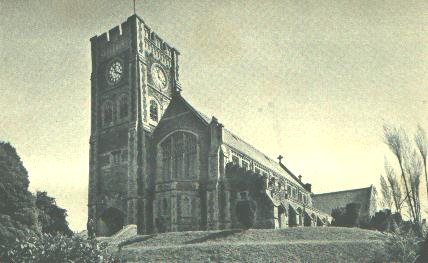ALL SAINTS CHURCH
CHURCH STREET
(scroll down for history)

ALL SAINTS CHURCH
CHURCH STREET
(scroll
down for history)

The church of All Saints is Ammanford's most imposing building, its clock tower being visible for miles around. Not that long ago its clock and hourly chimes provided the only means of telling the time for most people. The church is so large and dominating that it can come as a surprise to realize how recent a building it is.
St Tybie Church, Llandybie, can trace its origins to the fifth century and the stone church that currently graces the village was built around 1300 AD during the reign of Edward I. There is a Celtic origin too for St David's Church Betws, and today's building can also be dated to the thirteenth century. Both churches, however, experienced — or perhaps suffered would be a more accurate word — major renovations during the 19th century which destroyed much of the original medieval fabric of the buildings.
All Saints, however, is a spring chicken compared to these two genuinely ancient buildings, being built only in 1915. And then it was built without its distinguishing clock tower and belfry which were not added until 1923.
In fact, the first church in Ammanford was the much smaller, though no less attractive, St Michael's Church in Wind Street. This was built and dedicated in 1885 to rectify the rather embarrassing situation that the largest conurbation in the area, Ammanford, didn't have a church of its own. Plenty of chapels, certainly, with the earliest going back to the mid-eighteenth century. But no church.
But the building of St Michael's Church did nothing to solve the acute accommodation problem for church worshippers in Ammanford. A new Church Hall built in 1900 across the road from St Michael's Church was initially used both as a Sunday school and an overspill venue for the main church services, but there was still not enough room to take all would-be worshipers. So, in November 1903, a public meeting was convened to discuss the situation. Although one proposal at the meeting was to extend and enlarge St Michael's Church in Wind Street the other proposal, to build an entirely new parish church, was the overwhelmingly popular one. It's impossible to believe it now, but All Saints Church, seating 500 worshippers, was originally built to take the overflow from St Michael's.
Finally, Lady Dynevor laid a foundation stone in 1911 for the new parish church, to be named All Saints. As if to establish its supremacy over all other denominations in the town, the newcomer was built on the highest point in Ammanford, overlooking the town with a fine view over to the Betws mountain. The church building was funded by voluntary donations and public subscription and was built in two stages, the main section being completed in 1915. The planned tower, however, had to wait until 1923 to emerge, after the outbreak of World War I in 1914 caused a shortage of both manpower and building materials. The clock tower, when it was completed, was dedicated as a war memorial to the fallen of the Great War, 1914-1918.
All Saints Church also solved a language problem as well, it being decided that St Michael's would conduct its services in Welsh while All Saints would cater for the English speakers of the town.
In 1885, when St Michael's was built, Ammanford's population was 90 percent Welsh speaking with almost two-thirds speaking only Welsh. In 1851 the population of what would become Ammanford was 282. By The 1911 Census Ammanford's population had grown explosively to 6,074. While the Amman Valley was still around 90 percent Welsh speaking at this time, many of the incoming population came from non-Welsh speaking parts of Wales, with England, Scotland and Ireland also contributing to the immigration. The need for a separate church with services in English became apparent and All Saints was the result.
The website for the parish of Betws with Ammanford (All Saints church, Ammanford; St Michael's, Ammanford; St David's, Betws; St Thomas, Wernoleu) can be found on: Parish of Betws with Ammanford.